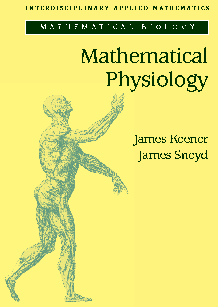
Math 6770 - Mathematical Biology (Mathematical Physiology)
Time: T Th 12:25-1:45 Room LCB 323
Text:
Keener and Sneyd, Mathematical Physiology, Volume 1
(Cell Physiology)

All proceeds from the sale of this text to students in this class will be donated to the Math Biology Development Fund in the Math Department.
Outline: This course will emphasize cell physiology and will follow (more or less) the topics of the first half of the text. The course will emphasize the mathematical modelling of cell physiology processes, with material drawn primarily from the Volume 1 of Keener and Sneyd. Topics will include enzyme kinetics, channel dynamics, action potential generation and excitability, calcium handling, metabolism, bursting and endocrine secretion, cell cycle dynamics, synaptic transmission, muscle contraction and molecular motors, to name a few. Additional topics will be added according to student interest.
Homework assignments will be posted and updated regularly at this .pdf file (with the .tex file here). Solutions for previous homework assignments are here.
In addition to homework problems, each student is expected to do a reading/research project on a topic/problem of choice. Proposals for each project must be submitted by Sept. 29, and the Final Project report will be due at the end of the class. In addition, each student will be required to give an in-class presentation describing the results of the project.
Notes: Here are xpp .ode files for the Selkov and Goldbeter-Lefever glycolysis models.
xpp file selkov.ode
xpp file Goldbeter_glycolysis.ode.
Here are .ode files for reduced HH equations and the Morris-Lecar model:
xpp file hhred.ode.
xpp file ML.ode.
xpp files CK.ode. and CK2D.ode as well as notes on how to use thes files to make pretty pictures.
Here is a file for stochastic simulation of a Markov model of a potassium channel, using Gillespie algorithm: xpp file n_state_potassium.m.
Here are some notes modifying the explanation of closed time probability for the sodium ion channel model in Section 3.6.1.
For more information contact J. Keener, 1-6089